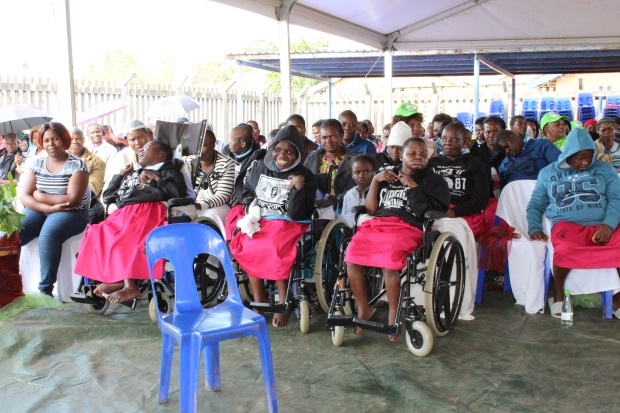Vicky Anne Bloxham was sacked by University Hospitals of Coventry and Warwickshire NHS Trust.
Monthly Archives: October 2017
Making glass invisible: A nanoscience-based disappearing act
[unable to retrieve full-text content]

Research aims to help renewable jet fuel take flight
[unable to retrieve full-text content]

Right whales, already an endangered species, may face a dim future
[unable to retrieve full-text content]

IVF: Patients face postcode lottery for treatment
Figures show just 24 of 208 clinical commissioning groups offer three rounds of IVF treatment.
Health24.com | Mentally ill patients in Limpopo face great challenges
Families who refuse to look after mentally ill relatives, stigmatisation of the issue by communities, minimal patient visits and a shortage of water are plaguing the running of the Hayani Specialised Psychiatric Hospital, outside Thohoyandou in Limpopo.
Mental Health Month
Acting CEO of the hospital, Robert Lavhelani said, “We have the challenge of families who just come here and dump their mentally ill siblings. They never bother to visit again to monitor their progress. Some of the patients have been living here for years without their family having ever visited them.”
Lavhelani was speaking during a recent celebration hosted at the hospital to celebrate Mental Health Month.
He said that families who neglect mentally ill patients fuel the stigma against mental health.
“We have managed to track down some of the families of patients who have been with us for many years. But when we try to re-unite them, the families swear and insult us, saying that they have nothing to do with people who are mentally ill.”
Shortage of running water
“These are some of the things which negatively affect the work we are doing with our patients. Families must also play their part for us to end the stigma around mental illness,” he said.
Hayani is the only hospital in Vhembe able to accommodate all patients suffering from mental illnesses.
The hospital, which is situated at Makwarela township, also faces a shortage of running water.
Lavhelani said they have been trying to raise the issue with the Vhembe District Municipality for “quite some time now”.
Mashudu Netshifhefhe, a former patient at the hospital, said the stigma associated with mental illness made it difficult for patients to cope when they were finally discharged from hospital.
Mental illness can be treated
“Life becomes even harder when people know that you have a mental illness. They treat you like a dog and even your closest family members distance themselves from you. Some people, when they see you, they run for their lives,” said Netshifhefhe.
He has been living with bipolar for more than 10 years. He was diagnosed after he was retrenched from work.
“People need to be taught that a mental illness is like any other disease and can be treated if the patient takes their medication correctly. We need support from society, friends and family members for us to be well. We did not choose to have all these mental illnesses. And those who do not have supportive family members must join churches when they are discharged, as pastors will never discriminate against them but will support them to be better individuals,” added Netshifhefhe. – Health-e News.
Image credits: Supplied
NEXT ON HEALTH24X

Health24.com | ‘I’m a nutritionist and this is the eating secret I swear by’
I’ve always been into health and fitness. In high school, I worked in fitness centres and was really into eating healthy.
Now, I’m a registered dietician, so my love for soups and smoothies naturally evolved from my knowledge and personal health habits.
I’d go to smoothie shops if I was out, and for dinner I’d just have leftover veggies on hand at home so I’d make soups with them.
I love them so much I worked with Women’s Health to write a whole book about them: The Women’s Health Big Book Of Smoothies & Soups. I consider them my healthy secret weapon.
Read more: Here’s why your workout might be making you bloated
Soups and smoothies are a quick and easy way to get your fruit and veggie fix – and most people are not getting enough of either. In one smoothie, you can get two servings of fruit and three of veggies without feeling like you’re eating spinach.
The protein, antioxidants, vitamins and minerals help boost the your energy and your moods without feeling weighed down or sleepy like you do after eating a big bowl of pasta.
They’re ideal if you’re busy or stressed and don’t feel like cooking a meal and sitting down to eat it.
I probably have a smoothie five to six times a week now, usually as a lunchtime meal replacement or breakfast on busy days. It’s cold and refreshing and helps get my blood sugar up when I’m not super hungry.
I love a peanut-butter banana protein smoothie with almond milk or, if I’m not in the mood for that, one with berries and yogurt. I’ll bring it in the car and sip on it as I’m running errands.
Read more: 8 foods to eat tonight to de-bloat by tomorrow
Veggies are sometimes a challenge because they can go bad in the fridge before you get around to cooking them. That’s where soups come in especially handy: I usually make one big batch once a month and freeze it.
I like blending in cannellini beans, which gives soups a creamy flavour without adding heavy cream, along with lots of veggies like potatoes, carrots and spinach.
I’ll pull it out two nights a week, more often during the winter, to eat before dinner instead of salad. They’re great because they fill you up and satisfy you so don’t overdo it on the rest of your meal.
To keep your smoothies healthy, I recommend adding one cup of frozen or fresh fruit max and balancing with veggies and a source of protein (like a powder, peanut butter or yogurt) to make it a complete meal. With soups, skip those that are heavy on the cheese and cream, because they can get really high in kilojoules.
To keep the sodium in check, go for low-sodium veggie and chicken broth, or if you’re buying the canned stuff look for 400 to 500mg sodium max.
Read more How to ‘shrink’ your tummy in 24 hours
These days when I put on a few pounds over the holidays, I fall back on soups and smoothies to reset and get my diet back on track. If I overdo it on the weekend, I feel bloated and I’m not all that hungry on Monday.
Having a smoothie is always a great way to reset my diet and manage my weight by keeping my weekly calories balanced. I also find my skin doesn’t break out as much when I’m eating lots of homemade soups and smoothies because they both have lots of liquid, keeping me nourished and hydrated.
Making them helped transform my health – I can’t imagine life without them!
This article was originally published on www.womenshealthsa.co.za
Image credit: iStock
NEXT ON HEALTH24X

The nurse hired to combat cancer myths online
A cancer charity said myths online leave patients “scared and at risk of bogus cures”.
NHS Airbnb-style scheme ‘not ruled out’ by minister
A minister says the idea of patients being discharged to people’s spare rooms must be scrutinised.
Health24.com | What you need to know about collarbone breaks
“It has to do with the way cyclists tend to fall,” says Dr Brian Cunningham, MD, a Minnesota-based orthopedic trauma specialist.
“When you fall directly onto your shoulder, your clavicle [or collarbone] – which has an s-shape – compresses and is prone to breaking.”
You’ll know you’ve broken your collarbone almost immediately, says Dr Subir Jossan, MD, an orthopaedic surgeon with the DC-area Centers for Advanced Orthopaedics.
It’s not a subtle injury – moving your arm will be agonising and you may hear an audible crack as you hit the ground.
The big issue with this break is that when it heals right, it won’t impair your long-term function – but that doesn’t always happen, and the repercussions extend beyond your collarbone.
The collarbone acts as a strut connecting your arm to your chest; any kink in that system could mean you’ll have prolonged problems.
“If it heals in a position where there’s shortness [meaning it doesn’t quite reach the shoulder joint], there may be some weakness,” says Dr Cunningham.
Here’s what you need to know about managing a collarbone break, and how to come back stronger.
What to do just after a break
If you suspect you’ve broken your clavicle, Dr Jossan says you do need to head immediately to your local ER or urgent care center.
It’s not that the bone needs to be reset right at that moment, Dr Jossan says, but that “there are some big, important blood vessels around the clavicle that could have been damaged.”
Read more: 6 signs you might have a blood clot
Treatment options
Once X-rays are done, the severity of the fracture will determine the course of treatment.
A sling: A tiny, hairline fracture is a pretty simple fix. Usually the doctor will put your corresponding arm in a sling and tell you to come back in six weeks.
The surgical option: If there’s any sort of displacement – meaning part of the bone has shifted – things get more complicated.
“The pendulum has swung from staying away from non-operative treatment to opting for surgery in certain situations,” says Dr Cunningham, adding that several recent studies have shown that those who opt for surgery have better function and much quicker recovery times.
In fact, patients can use their arms the day after surgery in many cases.
Read more: How pros crash… and get back up again
Collarbone surgery entails placing a small plate over the fracture. In about 10% of cases, the plate may have to be taken out later; this is especially common in women who report irritation with purse or bra straps rubbing over the area above the plate.
In cases where the cyclist has also sustained some sort of leg damage, the surgery can be super helpful, since your shoulders can tolerate crutches the next day.
Still, there are risks to any surgery. “If you don’t have surgery, there’s a zero percent chance you’ll get an infection and a zero percent chance of needing to have hardware taken out,” Dr Cunningham says.
If you skip surgery but the break isn’t healing properly, you may endure six to eight weeks of mild discomfort only to find out that you have to have surgery anyway.
Read more: This is your body during a crash
Prognosis for recovery
In the course of post-break recovery, many cyclists notice a collarbone “bump” – a bit of callus where the bone heals, says Dr Jossan.
Whether you end up with one is somewhat determined by random chance, but if you don’t have much in the way of body fat, whatever bump you get will be much more noticeable. As long as everything heals properly, a collarbone fracture shouldn’t increase your chances of getting another down the road.
“If it heals right, it’s like it never broke,” says Dr Jossan. “If it doesn’t heal right, though, some fall may break it again,” he warns.
That’s is why you need to take this particular bicycling injury seriously. If you fall shoulder-first onto the pavement and think you could have done damage, seek medical attention.
Don’t consider a broken collarbone a death sentence to your riding. Dr Cunningham says that you’ll likely be able to get back to riding quickly.
With surgery you could even be back in the saddle in just a few days. Without, you may be stuck on a trainer for at least six weeks.
Either way, you’ll have a great story to tell at your next group ride – and you may even have a trophy bump to show.
This article was originally published on www.bicycling.co.za
Image credit: iStock
NEXT ON HEALTH24X






